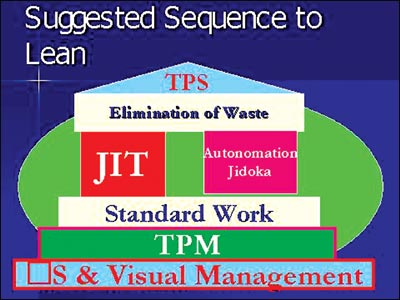TPM, a supportive tool for lean manufacturing
Thilak Pushpakumara CEO/Lean Management Consultant
Institute of Lean Management (Pvt) Ltd.
Today we are in a Liberalized, Globalized and Privatized (LGP) world
where the price of a product or service is more crucial. Before the LGP
world, manufacturers added their profit to cost and decided the price.
(Cost +Profit=Price) but today, Profit = Price-Cost. Hence, the Cost
factor will decide the future of any business. There are many ways to
cut down cost but we cannot compromise Quality because we are in a LGP
world. In the Pre LGP world we spoke about customer satisfaction but now
we drive towards delighting customers.
What is the difference between satisfied customer and delighted
customer?
A satisfied customer will buy from us, and a delighted customer will
sell for us. Making our product or service available is another crucial
factor in a LGP world.
Speed to market, on time delivery in full has become a part of our
business life. Everybody is trying their best to maximize value
(Quality, Cost, Delivery) to be competitive in a LGP world.

Most of the organizations have chosen lean manufacturing or lean/six
sigma as a tool to maximize value and expect quick results. Toyota
Production System (TPS) is their benchmark.
Lean manufacturing concept was developed based on Toyota way of
working. Toyota Production System, TPS mainly concentrate on waste
elimination through Just In Time (JIT) and Jidoka (Autonomation)
concepts. But the foundation is 5S and visual management followed by
standardized work. Gradually Toyota implemented Total Productive
Maintenance (TPM) because they realised that they cannot challenge JIT
and Jidoka without developing multitasking people and reliable
equipment.
TPM provided solutions for these two while delivering tangible and
intangible benefits to the organization. And also it transformed people
and the plant and set up corporate culture which could challenge JIT and
Jidoka to eliminate waste.
Toyota took about 30 years to reach this level. But other industries
benchmark Toyota and try to achieve ultimate goal of waste elimination
without following the correct path. We should not spend even 10 years to
reach this level since Toyota has developed the concept and we could
benchmark it.
Time is important in a competitive business environment but following
the right sequence is more important because it takes you to World Class
without fail and with sustainability.
What is lean?
Lean is a business philosophy that was first developed by Taichi
Ohono in 90s with particular focus on manufacturing firms. Now it is
applied in various industries for improving their business and reducing
all sources of waste, losses and non-value adding activities.
Lean provides the way to do more and more with less and less human
effort, inventory, machines, space and time while becoming closer to
customers providing exactly what they need.
The main focus of lean is, systematic elimination of waste. Inventory
reduction plays a major role in lean because it brings quick cash to the
business and cash flow is improved. Material and information flow
analysis (MIFA) needs to be done before reducing inventory, which is
called value stream mapping.
After successful completion of MIFA, Lean practitioners reduce Work
In Progress (WIP) and inventory and introduce “Kanban” cards and Kanban
post proudly. After a month time they tend to revise the standards
because of unpredicted machine breakdowns, operator absenteeism,
non-availability of spare parts, raw and packing materials due to
logistic losses.
How can TPM support lean?
TPM teach us 16 losses in a manufacturing process. Machine related
losses (seven losses), people related/Management losses (Five losses),
yield losses (Three losses) and shut down loss under Kobetsu Kaizen
pillar. Planned Maintenance, Autonomous Maintenance, Early Management
and Education and Training (E and T) pillar activities directly
contribute to achieve zero failure.
The detail assessment of spare parts management is done under planned
maintenance pillar and develops strategies to make sure availability of
spare parts while maintaining low inventory cost. Kobetsu kaizen pillar
activities increase the capacity of the machine and challenge name plate
capacity and go beyond the manufacturers’ recommendations while
protecting the equipment and lifecycle of the machine.
Developing multitasking operators through Autonomous Maintenance,
Education and Training and Kobetsu Kaizen pillar activities will help to
deliver value with less human effort. Unexpected absenteeism will not be
a big issue if we have enough multitasking operators.
Office TPM or TPM in supply chain will address the five logistic
losses and make sure material availability for production. This pillar
is specially designed to address inefficiencies in administration
functions.
Equipment and people safety is a key area to focus if we challenge
JIT. Safety health and Environment pillar activities are designed to
address this issue. First time right all the time, is a mandatory
requirement in JIT. Quality Maintenance (QM) pillar activities in TPM
systematically handle this issue.
Quality Control and Quality Assurance department activities will be
minimized and easier when QM pillar activities are in action because QM
activities investigate the mechanism of the machine and address all
malfunctions which leads to produce defects. In general, the focus in
these areas by lean practitioners is less due to multiple reasons. But
in the middle of the lean journey they realize the importance of TPM in
lean manufacturing.
TPM practitioners have better understanding in World Class journey
and sequence than others because the eight pillars of TPM covers the
entire business process. None of the organizations can challenge World
Class Status only with TPM and also none of the organizations can
challenge World Class without implementing TPM at the early stage in
their journey towards World Class. |



